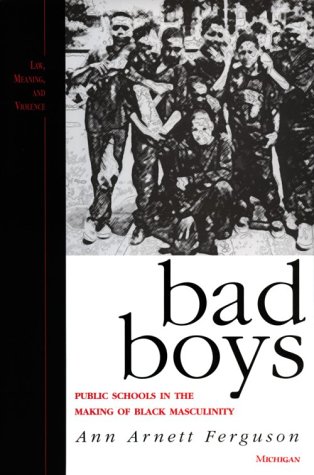
Bad Boys: Public Schools in the Making of Black Masculinity (Law, Meaning, And Violence)
Author: Ann Arnett Ferguson Category: Books for Educators, For Boys, Prejudice and Racism, Prison and Criminal Sentencing Publisher: University of Michigan Press Reading Age: Educators or Parents More DetailsStatistics show that black males are disproportionately getting in trouble and being suspended from the nation’s school systems. Based on three years of participant observation research at an elementary school, Bad Boys offers a richly textured account of daily interactions between teachers and students to understand this serious problem.
Ann Arnett Ferguson demonstrates how a group of eleven- and twelve-year-old males are identified by school personnel as “bound for jail” and how the youth construct a sense of self under such adverse circumstances. The author focuses on the perspective and voices of pre-adolescent African American boys. How does it feel to be labeled “unsalvageable” by your teacher? How does one endure school when the educators predict one’s future as “a jail cell with your name on it?” Through interviews and participation with these youth in classrooms, playgrounds, movie theaters, and video arcades, the author explores what “getting into trouble” means for the boys themselves. She argues that rather than simply internalizing these labels, the boys look critically at schooling as they dispute and evaluate the meaning and motivation behind the labels that have been attached to them.
Supplementing the perspectives of the boys with interviews with teachers, principals, truant officers, and relatives of the students, the author constructs a disturbing picture of how educators’ beliefs in a “natural difference” of black children and the “criminal inclination” of black males shapes decisions that disproportionately single out black males as being “at risk” for failure and punishment.
Bad Boys is a powerful challenge to prevailing views on the problem of black males in our schools today. It will be of interest to educators, parents, and youth, and to all professionals and students in the fields of African-American studies, childhood studies, gender studies, juvenile studies, social work, and sociology, as well as anyone who is concerned about the way our schools are shaping the next generation of African American boys.
Bad Boys: Public Schools in the Making of Black Masculinity (Law, Meaning, And Violence)
Written by Ann Arnett Ferguson
Foreword by Pedro A. Noguera
Source: Publisher (University of Michigan Press)
Other Books From - Books for Educators
About the author
Back
 Anti-Blackness at School: Creating Affirming Educational Spaces for African American Students
Anti-Blackness at School: Creating Affirming Educational Spaces for African American Students  “We Dare Say Love”: Supporting Achievement in the Educational Life of Black Boys
“We Dare Say Love”: Supporting Achievement in the Educational Life of Black Boys  Why Race and Culture Matter in Schools: Closing the Achievement Gap in America’s Classrooms
Why Race and Culture Matter in Schools: Closing the Achievement Gap in America’s Classrooms  Finding Your Blind Spots: Eight Guiding Principles for Overcoming Implicit Bias in Teaching
Finding Your Blind Spots: Eight Guiding Principles for Overcoming Implicit Bias in Teaching  The Unapologetic Workbook for Black Mental Health: A Step-by-Step Guide to Build Psychological Fortitude and Reclaim Wellness
The Unapologetic Workbook for Black Mental Health: A Step-by-Step Guide to Build Psychological Fortitude and Reclaim Wellness  The Unapologetic Guide to Black Mental Health: Navigate an Unequal System, Learn Tools for Emotional Wellness, and Get the Help You Deserve
The Unapologetic Guide to Black Mental Health: Navigate an Unequal System, Learn Tools for Emotional Wellness, and Get the Help You Deserve  Reckoning With Racism in Family–School Partnerships: Centering Black Parents’ School Engagement
Reckoning With Racism in Family–School Partnerships: Centering Black Parents’ School Engagement
Recent Comments